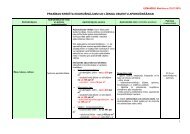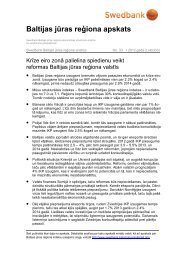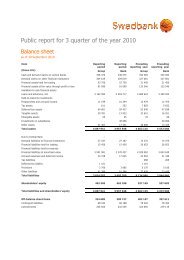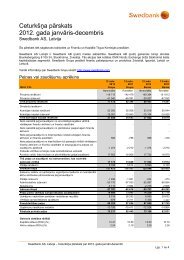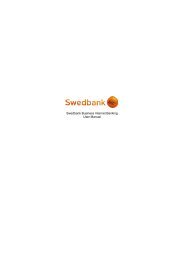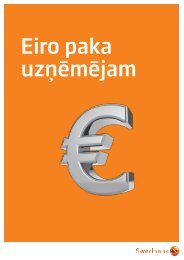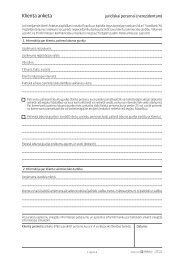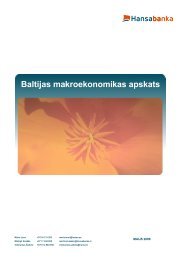Guide for Transactions in Financial Instruments - Swedbank
Guide for Transactions in Financial Instruments - Swedbank
Guide for Transactions in Financial Instruments - Swedbank
You also want an ePaper? Increase the reach of your titles
YUMPU automatically turns print PDFs into web optimized ePapers that Google loves.
<strong>Guide</strong> to <strong>Transactions</strong> <strong>in</strong> F<strong>in</strong>ancial <strong>Instruments</strong><br />
© <strong>Swedbank</strong>
<strong>Transactions</strong> which require the <strong>in</strong>vestor to enter <strong>in</strong>to the Agreement <strong>for</strong> Securities Account/Brokerage Services<br />
Transaction<br />
name<br />
Open-Ended<br />
Investment<br />
Funds<br />
Transaction description<br />
An <strong>in</strong>vestment fund (mutual<br />
fund) represents a<br />
professionally managed<br />
collective <strong>in</strong>vestment<br />
scheme that pools money<br />
from a number of <strong>in</strong>vestors,<br />
seek<strong>in</strong>g profit from<br />
appreciation of the<br />
<strong>in</strong>vestment under the<br />
selected <strong>in</strong>vestment<br />
strategy. The fund assets<br />
are <strong>in</strong>vested <strong>in</strong> various<br />
f<strong>in</strong>ancial <strong>in</strong>struments and<br />
bank deposits depend<strong>in</strong>g<br />
on the fund’s <strong>in</strong>vestment<br />
policy set out <strong>in</strong> the<br />
prospectus of each fund.<br />
Investment funds can be<br />
classified by their<br />
<strong>in</strong>vestment target:<br />
money market funds;<br />
bond funds;<br />
equity funds.<br />
Funds can also have their<br />
<strong>in</strong>vestments focused on a<br />
specific sector or <strong>in</strong>dustry.<br />
By <strong>in</strong>vest<strong>in</strong>g <strong>in</strong> <strong>in</strong>vestment<br />
funds, the <strong>in</strong>vestor acquires<br />
ownership of securities –<br />
fund units – the quantity of<br />
which depends on the<br />
amount of <strong>in</strong>vestment.<br />
Risk profile, leverage,<br />
<strong>in</strong>vestment loss risk, price<br />
fluctuation, restrictions on<br />
available market, potential<br />
liabilities, marg<strong>in</strong> processes<br />
Those who buy fund units are<br />
exposed to the risk that their<br />
<strong>in</strong>vestment value may fall <strong>in</strong><br />
value <strong>in</strong> part or at the extent of<br />
the entire sum <strong>in</strong>vested.<br />
The degree of risk associated<br />
with the <strong>in</strong>vestment fund varies<br />
depend<strong>in</strong>g on the fund’s<br />
<strong>in</strong>vestment policy. By risk level,<br />
they can be ranked as follows,<br />
with less risky listed first:<br />
money market funds;<br />
<strong>in</strong>vestment grade bond<br />
funds;<br />
high yield bond funds;<br />
balanced funds;<br />
funds of funds;<br />
equity funds;<br />
sector equity funds.<br />
The risk profile of each fund is<br />
described <strong>in</strong> the prospectus of<br />
the relevant fund. The<br />
prospectuses of funds<br />
distributed by <strong>Swedbank</strong> AS<br />
(<strong>Swedbank</strong>) are published on<br />
<strong>Swedbank</strong>’s Internet Bank<strong>in</strong>g<br />
site <strong>in</strong> section “Investments,<br />
sav<strong>in</strong>gs, pensions” / All funds”<br />
<strong>in</strong> the <strong>in</strong><strong>for</strong>mation shown under<br />
the name of the fund.<br />
Execution venue, settlement<br />
procedures<br />
<strong>Transactions</strong> <strong>in</strong> <strong>in</strong>vestment fund units<br />
are conducted over-the-counter.<br />
Settlements are made <strong>in</strong> the client’s<br />
accounts with <strong>Swedbank</strong>.<br />
To f<strong>in</strong>d out the exact procedure of<br />
settlements <strong>for</strong> a specific fund's units,<br />
the <strong>in</strong>vestor should see the provisions<br />
of the prospectus of the fund <strong>in</strong><br />
question prior to undertak<strong>in</strong>g a<br />
transaction. Settlements <strong>for</strong> a<br />
customer’s transaction <strong>in</strong> funds units<br />
are normally completed with<strong>in</strong> a couple<br />
of days (depend<strong>in</strong>g on the settlements<br />
procedure <strong>in</strong> place with the fund <strong>in</strong><br />
question) after establish<strong>in</strong>g the<br />
purchase and sales price of funds<br />
units.<br />
The purchase and sales prices of fund<br />
units are established accord<strong>in</strong>g to<br />
prospectus of the respective fund. In<br />
submitt<strong>in</strong>g an order <strong>for</strong> purchas<strong>in</strong>g or<br />
sell<strong>in</strong>g funds units, <strong>in</strong>vestors should<br />
take account of the fact that the price<br />
at which units are purchased or sold is<br />
normally established one or two<br />
bus<strong>in</strong>ess days after the order is<br />
submitted (depend<strong>in</strong>g on the<br />
settlements procedure <strong>in</strong> place with the<br />
fund <strong>in</strong> question). The unit price is<br />
subject to change every bus<strong>in</strong>ess day,<br />
there<strong>for</strong>e prices at which orders are<br />
executed may differ from the price of<br />
the unit published at the time the order<br />
was given.<br />
Direct costs and associated<br />
expenses<br />
Direct costs:<br />
fund unit purchase price,<br />
commission fees and<br />
<strong>in</strong>vestment management<br />
company’s costs <strong>in</strong>cluded <strong>in</strong><br />
the fund unit’s price and not<br />
payable separately, the size<br />
of which is described <strong>in</strong> the<br />
prospectus of the relevant<br />
fund;<br />
<br />
<br />
<br />
fees charged by the bank<br />
accord<strong>in</strong>g to the bank's price<br />
list:<br />
– fund unit purchase fee;<br />
– fund unit sales fee;<br />
– fund unit exchange fee;<br />
securities account<br />
ma<strong>in</strong>tenance fee if there are<br />
any fund units <strong>in</strong> the<br />
account.<br />
fees potentially charged by<br />
the <strong>in</strong>vestment fund’s<br />
management company (if<br />
such are provided <strong>for</strong> <strong>in</strong> the<br />
prospectus):<br />
– fund unit purchase fee;<br />
– fund unit sales fee;<br />
– fund unit exchange fee.<br />
An additional transaction fee<br />
may apply <strong>in</strong> the events provided<br />
<strong>for</strong> <strong>in</strong> the bank’s price list.<br />
Payments received<br />
by the bank <strong>for</strong><br />
distribution of<br />
<strong>in</strong>vestment funds<br />
There is a possibility<br />
of the bank receiv<strong>in</strong>g,<br />
from the <strong>in</strong>vestment<br />
fund management<br />
company, a fee <strong>for</strong><br />
distribution of funds<br />
at up to 70% of the<br />
fund management<br />
fee.<br />
Customers can<br />
contact the bank <strong>for</strong><br />
<strong>in</strong><strong>for</strong>mation on<br />
payments received<br />
by the bank from<br />
<strong>in</strong>vestment fund<br />
management<br />
companies.<br />
The number of fund units purchased is<br />
calculated by divid<strong>in</strong>g the transaction<br />
Associated costs are <strong>in</strong>curred by<br />
fees <strong>for</strong>:
amount specified <strong>in</strong> the order by the<br />
price of one fund unit. If the fund units<br />
are not divisible, the number of fund<br />
units purchased is rounded down to<br />
the whole number and the difference<br />
between the transaction amount<br />
specified <strong>in</strong> the order and the value of<br />
the executed order is returned to the<br />
customer’s current account.<br />
– open<strong>in</strong>g and ma<strong>in</strong>tenance<br />
of cash and securities<br />
accounts;<br />
– currency exchange;<br />
– other operations with<br />
accounts.<br />
Associated costs are payable<br />
accord<strong>in</strong>g to the price list of the<br />
bank.<br />
<strong>Transactions</strong> which require the Agreement <strong>for</strong> Securities Account/Brokerage Services<br />
Transaction<br />
name<br />
Real<br />
Estate<br />
Funds<br />
Exchange-<br />
Traded<br />
Funds<br />
(ETFs)<br />
Transaction description<br />
Real estate funds represent a<br />
professionally managed collective<br />
<strong>in</strong>vestment scheme that pools<br />
money from a number of<br />
<strong>in</strong>vestors, seek<strong>in</strong>g maximum profit<br />
under the selected <strong>in</strong>vestment<br />
strategy. The fund assets are<br />
<strong>in</strong>vested <strong>in</strong> various real estate<br />
development projects. As a<br />
general rule, these funds are<br />
closed-ended and of limited<br />
duration.<br />
The <strong>in</strong>vestment structure of<br />
exchange-traded funds typically<br />
replicate a certa<strong>in</strong> market <strong>in</strong>dex.<br />
These funds are traded as<br />
shares.<br />
Risk profile, leverage, <strong>in</strong>vestment loss risk, price<br />
fluctuation, restrictions on available market, potential<br />
liabilities, marg<strong>in</strong> processes<br />
Those who buy real estate fund units are exposed to risk<br />
that the <strong>in</strong>vestment may fall <strong>in</strong> value. The degree of risk<br />
varies depend<strong>in</strong>g on the fund’s <strong>in</strong>vestment policy.<br />
Investors <strong>in</strong> closed-ended funds should be aware of the<br />
liquidity risk as the fund is typically under no obligation to<br />
redeem fund units be<strong>for</strong>e the pay-out date agreed <strong>in</strong><br />
advance.<br />
The risk profile of each fund is described <strong>in</strong> the prospectus<br />
of the fund of choice. The prospectuses of funds that are<br />
<strong>in</strong> public circulation and registered <strong>in</strong> Latvia are published<br />
<strong>in</strong> <strong>Swedbank</strong> Internet bank<strong>in</strong>g site <strong>in</strong> section<br />
Investor/Funds under the relevant fund.<br />
Those who buy ETFs are exposed to the risk that the<br />
<strong>in</strong>vestment may fall <strong>in</strong> value. The degree of risk varies<br />
depend<strong>in</strong>g on the <strong>in</strong>dex the fund is l<strong>in</strong>ked to.<br />
The sellers of exchange-traded fund units should be<br />
aware of missed <strong>in</strong>come if the price of units sold cont<strong>in</strong>ues<br />
to rise. This should not be treated as a risk of loss.<br />
Execution venue,<br />
settlement<br />
procedures<br />
<strong>Transactions</strong> <strong>in</strong><br />
<strong>in</strong>vestment fund<br />
units are conducted<br />
over-thecounter.<br />
Settlements are<br />
made <strong>in</strong> client’s<br />
accounts with<br />
<strong>Swedbank</strong>.<br />
<strong>Transactions</strong> <strong>in</strong><br />
exchange-traded<br />
fund units are<br />
conducted <strong>in</strong> stock<br />
exchanges.<br />
Settlements are<br />
made <strong>in</strong> client’s<br />
accounts with<br />
<strong>Swedbank</strong>.<br />
Direct costs and associated expenses<br />
Direct costs – fund unit purchase and sale<br />
fees, securities account ma<strong>in</strong>tenance fee if<br />
there is a positive balance of units on the<br />
account, which are collected by the bank<br />
and/or by the <strong>in</strong>vestment management<br />
company based on the prospectus of the<br />
relevant fund.<br />
Associated costs – a fee <strong>for</strong> securities<br />
account open<strong>in</strong>g, currency exchange and<br />
other account operations as per official price<br />
list of the bank.<br />
Indirect costs – fees and <strong>in</strong>vestment<br />
management company’s expenses covered<br />
by the price of fund units and not payable<br />
separately, the size of which is described <strong>in</strong><br />
the prospectus of the relevant fund.<br />
Direct costs – the fund unit purchase price,<br />
as well as purchase and sale fees<br />
determ<strong>in</strong>ed accord<strong>in</strong>g to the shares price list<br />
<strong>for</strong> bus<strong>in</strong>ess customers at<br />
http://www.swedbank.lv/eng/cenas/cenradis<br />
-u.php?nr=2-5 or private customers at<br />
http://www.swedbank.lv/eng/cenas/cenradis<br />
.php?nr=4-1.<br />
Where the securities trade currency is<br />
other than LVL, the transaction fee will be
charged <strong>in</strong> the relevant trade currency at<br />
the bank’s exchange rate.<br />
Associated costs – cash and securities<br />
account ma<strong>in</strong>tenance, money and unit<br />
transfers and other account operations as<br />
per price list<br />
http://www.swedbank.lv/eng/cenas/cenradis<br />
-u.php?nr=2-5 and<br />
http://www.swedbank.lv/eng/cenas/cenradis<br />
-u.php?nr=1-1 <strong>for</strong> bus<strong>in</strong>ess customers, as<br />
well as<br />
http://www.swedbank.lv/eng/cenas/cenradis<br />
.php?nr=4-1 and<br />
http://www.swedbank.lv/eng/cenas/cenradis<br />
.php?nr=1-1 <strong>for</strong> private customers.<br />
Stocks<br />
(shares,<br />
equities)<br />
A stock means a share of the<br />
company’s equity capital. There<br />
are different types of stocks<br />
(vot<strong>in</strong>g stock, non-vot<strong>in</strong>g stock,<br />
preferred stock, equity reserve,<br />
etc.) The parameters of specific<br />
stock issues is the responsibility<br />
of the issuer.<br />
Those who buy stock are exposed to the risk that their<br />
<strong>in</strong>vestment may fall <strong>in</strong> value <strong>in</strong> part or at the extent of the<br />
entire sum <strong>in</strong>vested.<br />
Those who sell stock should be aware of missed <strong>in</strong>come if<br />
the price of the stock sold cont<strong>in</strong>ues to rise. This should<br />
not be treated as a risk of loss.<br />
<strong>Transactions</strong> are<br />
conducted <strong>in</strong> stock<br />
exchanges.<br />
In some cases,<br />
unlisted stock may<br />
be available <strong>for</strong><br />
purchase.<br />
Indirect costs – fees and <strong>in</strong>vestment<br />
management company’s expenses, the<br />
extent of which is described <strong>in</strong> the<br />
prospectus of the relevant fund.<br />
Direct costs – the stock purchase price, as<br />
well as purchase and sale fees determ<strong>in</strong>ed<br />
accord<strong>in</strong>g to the price list <strong>for</strong> bus<strong>in</strong>ess<br />
customers at<br />
http://www.swedbank.lv/eng/cenas/cenradis<br />
-u.php?nr=2-5 or private customers at<br />
http://www.swedbank.lv/eng/cenas/cenradis<br />
.php?nr=4-1.<br />
Clients can purchase or sell stock<br />
via bank.<br />
In some cases the bank can<br />
receive a sales commission <strong>for</strong><br />
share issue placement of up to<br />
10% of the stock value. In each<br />
particular case it is disclosed to<br />
the <strong>in</strong>vestor <strong>in</strong> the distribution<br />
<strong>in</strong><strong>for</strong>mation.<br />
Settlements are<br />
made <strong>in</strong> client’s<br />
accounts with<br />
<strong>Swedbank</strong>.<br />
Fees are charged <strong>for</strong> executed or partially<br />
executed transactions only. Where the<br />
securities trade currency is other than LVL,<br />
the transaction fee will be charged <strong>in</strong> the<br />
relevant trade currency at the bank’s<br />
exchange rate.<br />
Associated costs – cash and securities<br />
account ma<strong>in</strong>tenance, money and stock<br />
transfers and other account operations as<br />
per price list<br />
http://www.swedbank.lv/eng/cenas/cenradis<br />
-u.php?nr=2-5 and<br />
http://www.swedbank.lv/eng/cenas/cenradis<br />
-u.php?nr=1-1 <strong>for</strong> bus<strong>in</strong>ess customers, as<br />
well as
Debt<br />
securities<br />
Debt securities represent def<strong>in</strong>ed<br />
and marketable debt<br />
commitments, where the issuer of<br />
the debt security borrows and the<br />
buyer lends money. Maturity<br />
period, <strong>in</strong>terest rate, collateral and<br />
other essential parameters of<br />
debt securities are published by<br />
the issuer <strong>in</strong> the prospectus or are<br />
agreed by the issuer with the<br />
buyer <strong>in</strong>dividually.<br />
In some cases the bank can<br />
receive a sales commission <strong>for</strong><br />
debt securities issue placement of<br />
up to 10% of the debt securities<br />
value. In each particular case it is<br />
disclosed upon distribution of<br />
securities.<br />
Those who buy debt securities are exposed to the risk that<br />
their <strong>in</strong>vestment may fall <strong>in</strong> value <strong>in</strong> part or at the extent of<br />
the entire sum <strong>in</strong>vested.<br />
Those who sell debt securities should be aware of missed<br />
<strong>in</strong>come if the price of the security sold cont<strong>in</strong>ues to rise,<br />
however, this should not be treated as a risk of loss.<br />
The bank offers<br />
both exchange<br />
traded and overthecounter<br />
traded<br />
debt securities.<br />
One security may<br />
have one or several<br />
stock exchanges.<br />
Settlements are<br />
made <strong>in</strong> client’s<br />
accounts with<br />
<strong>Swedbank</strong>.<br />
http://www.swedbank.lv/eng/cenas/cenradis<br />
.php?nr=4-1 and<br />
http://www.swedbank.lv/eng/cenas/cenradis<br />
.php?nr=1-1 <strong>for</strong> private customers.<br />
Direct costs – the debt security purchase<br />
price, as well as purchase and sale fees<br />
determ<strong>in</strong>ed accord<strong>in</strong>g to the price list <strong>for</strong><br />
bus<strong>in</strong>ess customers at<br />
http://www.swedbank.lv/eng/cenas/cenradis<br />
-u.php?nr=2-5 or private customers at<br />
http://www.swedbank.lv/eng/cenas/cenradis<br />
.php?nr=4-1, or as agreed.<br />
Associated costs – cash and securities<br />
account ma<strong>in</strong>tenance, money and securities<br />
transfers and other account operations as<br />
per price list<br />
http://www.swedbank.lv/eng/cenas/cenradis<br />
-u.php?nr=1-1 <strong>for</strong> bus<strong>in</strong>ess customers and<br />
http://www.swedbank.lv/eng/cenas/cenradis<br />
.php?nr=1-1 <strong>for</strong> private customers.<br />
Extract from the price list:<br />
Foreign<br />
exchange<br />
spot<br />
Foreign<br />
exchange<br />
<strong>for</strong>ward<br />
Direct transactions <strong>in</strong> Riga Stock Exchange<br />
Buy<strong>in</strong>g Latvian treasury bills and bonds <strong>in</strong> auction – up to LVL 100,000<br />
Buy<strong>in</strong>g Latvian treasury bills and bonds <strong>in</strong> auction – <strong>in</strong> excess of LVL 100,000<br />
Tak<strong>in</strong>g part <strong>in</strong> auctions organized by Riga Stock Exchange<br />
A currency exchange transaction<br />
at a rate fixed at the time of<br />
transaction, <strong>in</strong> which settlements<br />
are made until the end of the<br />
second bank<strong>in</strong>g day follow<strong>in</strong>g the<br />
transaction clos<strong>in</strong>g date.<br />
A currency exchange transaction<br />
where settlements take place on<br />
a specified future date at the rate<br />
Transaction which require the Agreement <strong>for</strong> F<strong>in</strong>ancial Market <strong>Transactions</strong><br />
The transaction is<br />
done over-thecounter.<br />
The market value of <strong>for</strong>eign exchange <strong>for</strong>wards may<br />
fluctuate as long as until maturity, as it is determ<strong>in</strong>ed on<br />
the basis of currency rates and <strong>in</strong>terest rates <strong>in</strong>volved <strong>in</strong><br />
Settlements are<br />
made <strong>in</strong> client’s<br />
accounts with<br />
<strong>Swedbank</strong>.<br />
The transaction<br />
is done over-thecounter.<br />
As agreed<br />
0.20% of the par value<br />
0.15% of the par value<br />
As agreed<br />
The transaction has no direct costs – the<br />
<strong>for</strong>eign exchange price is reflected <strong>in</strong> the<br />
exchange rate.<br />
Associated costs – account ma<strong>in</strong>tenance,<br />
transfers and other account operations<br />
as per price list<br />
http://www.swedbank.lv/eng/cenas/cenradis<br />
-u.php?nr=1-1 <strong>for</strong> bus<strong>in</strong>ess customers and<br />
http://www.swedbank.lv/eng/cenas/cenradis<br />
.php?nr=1-1 <strong>for</strong> private customers.<br />
The transaction has no direct costs – the<br />
<strong>for</strong>eign exchange price is reflected <strong>in</strong> the<br />
exchange rate.
of exchange agreed between the<br />
bank and the client at the time of<br />
transaction. 3 bus<strong>in</strong>ess days is<br />
the m<strong>in</strong>imum period <strong>in</strong> <strong>for</strong>ward<br />
transactions. If the currency is<br />
exchanged 2 or less bus<strong>in</strong>ess<br />
days after the transaction, it will<br />
not be treated as a <strong>for</strong>eign<br />
exchange <strong>for</strong>ward, but <strong>in</strong>stead a<br />
regular <strong>for</strong>eign exchange<br />
transaction. The maximum period<br />
is not limited, but normally will not<br />
exceed 1 – 2 years.<br />
the transaction.<br />
The need <strong>for</strong> collateral will be considered <strong>in</strong> each case<br />
<strong>in</strong>dividually. The amount of collateral depends on the<br />
maturity period and the currencies <strong>in</strong>volved <strong>in</strong> the<br />
transaction, normally 2 – 10% of the transaction amount.<br />
For longterm transactions and selected currencies – up to<br />
15%.<br />
Liquidity risk. If the transaction is backed by a pledge over<br />
cash, securities or other f<strong>in</strong>ancial <strong>in</strong>struments, there may<br />
be cases where the client will be required to provide an<br />
additional collateral to cont<strong>in</strong>ue the transaction.<br />
Settlements are<br />
made <strong>in</strong> client’s<br />
accounts with<br />
<strong>Swedbank</strong>.<br />
Associated costs – account ma<strong>in</strong>tenance,<br />
transfers and other account operations<br />
as per price list<br />
http://www.swedbank.lv/eng/cenas/cenradis<br />
-u.php?nr=1-1 <strong>for</strong> bus<strong>in</strong>ess customers and<br />
http://www.swedbank.lv/eng/cenas/cenradis<br />
.php?nr=1-1 <strong>for</strong> private customers.<br />
Foreign<br />
exchange<br />
swap<br />
Forex swaps consist of two<br />
opposite <strong>for</strong>eign exchange<br />
transactions: spot and <strong>for</strong>ward.<br />
Both settlements dates and<br />
exchange rates are fixed at the<br />
time of enter<strong>in</strong>g <strong>in</strong>to the<br />
transaction.<br />
The risk of loss of the collateral <strong>in</strong> part or <strong>in</strong> whole. Where<br />
the client is unable to provide an additional collateral and<br />
market value of the <strong>for</strong>eign exchange <strong>for</strong>ward is negative<br />
<strong>for</strong> the client, the bank may use the current collateral to<br />
close the client’s position.<br />
The value of <strong>for</strong>ex swaps fluctuates but less so than the<br />
<strong>for</strong>ward <strong>for</strong>eign exchange transactions, as it only depends<br />
on changes <strong>in</strong> the <strong>in</strong>terest rates of currencies <strong>in</strong>volved <strong>in</strong><br />
the transaction, and not the exchange rates.<br />
The need <strong>for</strong> collateral will be considered <strong>in</strong> each case<br />
<strong>in</strong>dividually. The amount of collateral depends on the<br />
maturity period and the currencies <strong>in</strong>volved <strong>in</strong> the<br />
transaction, normally 2 – 10% of the transaction amount.<br />
For long-term transactions and selected currencies – up to<br />
15%.<br />
The transaction is<br />
done over-thecounter.<br />
Settlements are<br />
made <strong>in</strong> client’s<br />
accounts with<br />
<strong>Swedbank</strong>.<br />
The transaction has no direct costs – the<br />
<strong>for</strong>eign exchange price is reflected <strong>in</strong> the<br />
exchange rate.<br />
Associated costs – account ma<strong>in</strong>tenance,<br />
transfers and other account operations<br />
as per price list<br />
http://www.swedbank.lv/eng/cenas/cenradis<br />
-u.php?nr=1-1 <strong>for</strong> bus<strong>in</strong>ess customers and<br />
http://www.swedbank.lv/eng/cenas/cenradis<br />
.php?nr=1-1 <strong>for</strong> private customers.<br />
Liquidity risk. If the transaction is backed by a pledge over<br />
cash, securities or other f<strong>in</strong>ancial <strong>in</strong>struments, there may<br />
be cases where the client will be required to provide an<br />
additional collateral to cont<strong>in</strong>ue the transaction.<br />
Interest<br />
rate swap<br />
An <strong>in</strong>terest rate swap means an<br />
arrangement between the bank<br />
and the client to exchange, over a<br />
certa<strong>in</strong> period of time, periodic<br />
<strong>in</strong>terest payments from a certa<strong>in</strong><br />
The risk of loss of the collateral <strong>in</strong> part or <strong>in</strong> whole. Where<br />
the client is unable to provide an additional collateral and<br />
market value of the <strong>for</strong>eign exchange swap is negative <strong>for</strong><br />
the client, the bank may use the current collateral to close<br />
the client’s position.<br />
The value of the transaction depends on <strong>in</strong>terest rate<br />
fluctuations <strong>in</strong> the relevant currency. The longer the period<br />
of transaction, the more the market value fluctuates.<br />
The need <strong>for</strong> collateral will be considered <strong>in</strong> each case<br />
The transaction is<br />
done over-thecounter.<br />
Settlements are<br />
The transaction has no direct costs – the<br />
price is reflected <strong>in</strong> <strong>in</strong>terest rates.<br />
Associated costs – account ma<strong>in</strong>tenance,<br />
transfers and other account operations as
pr<strong>in</strong>cipal amount <strong>in</strong> one currency.<br />
Interest rates can be either<br />
float<strong>in</strong>g (e.g. 6M EURIBOR) or<br />
fixed. The pr<strong>in</strong>cipal amount of the<br />
transaction is constant or may be<br />
amortized accord<strong>in</strong>g to a<br />
schedule.<br />
<strong>in</strong>dividually. The amount of collateral depends on the<br />
maturity period, normally 3 – 10% of the transaction<br />
amount.<br />
Liquidity risk. If the transaction is backed by a pledge over<br />
cash, securities or other f<strong>in</strong>ancial <strong>in</strong>struments, there may<br />
be cases where the client will be required to provide an<br />
additional collateral to cont<strong>in</strong>ue the transaction.<br />
made <strong>in</strong> client’s<br />
accounts with<br />
<strong>Swedbank</strong>.<br />
per price list<br />
http://www.swedbank.lv/eng/cenas/cenradis<br />
-u.php?nr=1-1 <strong>for</strong> bus<strong>in</strong>ess customers and<br />
http://www.swedbank.lv/eng/cenas/cenradis<br />
.php?nr=1-1 <strong>for</strong> private customers.<br />
Foreign<br />
exchange<br />
and <strong>in</strong>terest<br />
rate swap<br />
Foreign<br />
exchange<br />
option<br />
The simplest <strong>for</strong>m of the<br />
transaction is a simultaneous<br />
exchange of a float<strong>in</strong>g rate loan<br />
<strong>for</strong> a fixed rate loan or vice versa.<br />
FX and <strong>in</strong>terest rate swap means<br />
an arrangement between the<br />
bank and the client to exchange,<br />
over a certa<strong>in</strong> period of time,<br />
periodic <strong>in</strong>terest payments from a<br />
certa<strong>in</strong> pr<strong>in</strong>cipal amount. The<br />
pr<strong>in</strong>cipals <strong>in</strong> different currencies<br />
maybe exchanged at the start or<br />
end of the transaction.<br />
Interest rates <strong>in</strong> each currency<br />
can be either float<strong>in</strong>g (e.g. 6M<br />
EURIBOR) or fixed. The pr<strong>in</strong>cipal<br />
amount of the transaction is<br />
constant or may be amortized<br />
accord<strong>in</strong>g to a schedule.<br />
The simplest <strong>for</strong>m of the<br />
transaction is an exchange<br />
between counterparties of loans<br />
<strong>in</strong> 2 different currencies and with<br />
different rates.<br />
FX options are contracts where<br />
the owner has the right but is not<br />
under an obligation to buy or sell<br />
the base currency at a certa<strong>in</strong><br />
price on a certa<strong>in</strong> future date.<br />
The seller of the option has an<br />
obligation to sell, upon the<br />
buyer’s request, the base<br />
currency to the buyer at a pre-<br />
The risk of loss of the collateral <strong>in</strong> part or <strong>in</strong> whole. Where<br />
the client is unable to provide an additional collateral and<br />
market value of the <strong>in</strong>terest rate swap is negative <strong>for</strong> the<br />
client, the bank may use the current collateral to close the<br />
client’s position.<br />
The value of the transaction depends on <strong>in</strong>terest rate<br />
fluctuations <strong>in</strong> the relevant currency. The longer the period<br />
of transaction, the more the value fluctuates.<br />
The need <strong>for</strong> collateral will be considered <strong>in</strong> each case<br />
<strong>in</strong>dividually. The amount of collateral depends on the<br />
maturity period and the currencies <strong>in</strong>volved <strong>in</strong> the<br />
transaction, normally 2 – 10% of the transaction amount.<br />
For long-term transactions and selected currencies – up to<br />
15%.<br />
Liquidity risk. If the transaction is backed by a pledge over<br />
cash, securities or other f<strong>in</strong>ancial <strong>in</strong>struments, there may<br />
be cases where the client will be required to provide an<br />
additional collateral to cont<strong>in</strong>ue the transaction.<br />
The risk of loss of the collateral <strong>in</strong> part or <strong>in</strong> whole. Where<br />
the client is unable to provide an additional collateral and<br />
market value of the FX and <strong>in</strong>terest rate swap is negative<br />
<strong>for</strong> the client, the bank may use the current collateral to<br />
close the client’s position.<br />
The buyer of the FX option will not <strong>in</strong>cur any loss as a<br />
result of exchange rate fluctuations, however, there is a<br />
risk of not earn<strong>in</strong>g any profit. The option premium here<br />
and thereafter is treated as a cost, not an <strong>in</strong>vestment. The<br />
option premium depends on:<br />
the expiration date<br />
FX market rate at the time of enter<strong>in</strong>g <strong>in</strong>to the<br />
transaction<br />
exchange rate volatility<br />
The transaction is<br />
done over-thecounter.<br />
Settlements are<br />
made <strong>in</strong> client’s<br />
accounts with<br />
<strong>Swedbank</strong>.<br />
The transaction is<br />
done over-thecounter.<br />
Settlements are<br />
made <strong>in</strong> client’s<br />
accounts with<br />
<strong>Swedbank</strong>.<br />
The transaction has no direct costs – the<br />
price is reflected <strong>in</strong> <strong>in</strong>terest rates.<br />
Associated costs – account ma<strong>in</strong>tenance,<br />
transfers and other account operations as<br />
per price list<br />
http://www.swedbank.lv/eng/cenas/cenradis<br />
-u.php?nr=1-1 <strong>for</strong> bus<strong>in</strong>ess customers and<br />
http://www.swedbank.lv/eng/cenas/cenradis<br />
.php?nr=1-1 <strong>for</strong> private customers.<br />
The seller of the option has no direct costs.<br />
The option buyer’s direct costs are the<br />
option premium paid at the time of enter<strong>in</strong>g<br />
<strong>in</strong>to the transaction.<br />
Associated costs – account ma<strong>in</strong>tenance,<br />
transfers and other account operations<br />
as per price list<br />
http://www.swedbank.lv/eng/cenas/cenradis
agreed exchange rate.<br />
The terms of the transaction are<br />
agreed at the time of enter<strong>in</strong>g <strong>in</strong>to<br />
the transaction. The rights and<br />
obligations of the counterparties<br />
expire upon maturity of the<br />
option.<br />
The option premium means the<br />
payment <strong>for</strong> the rights that the<br />
option gives its buyer.<br />
<br />
<br />
the exchange rate, at which the buyer wants to<br />
buy the currency<br />
<strong>in</strong>terest rates <strong>in</strong> both currencies.<br />
The seller of FX option risks to <strong>in</strong>cur unlimited loss, which<br />
can exceed the premium received, consequently, the bank<br />
can require a collateral.<br />
The need <strong>for</strong> collateral will be considered <strong>in</strong> each case<br />
<strong>in</strong>dividually. The amount of collateral depends on the<br />
maturity period and the currencies <strong>in</strong>volved <strong>in</strong> the<br />
transaction, normally 2 – 10% of the transaction amount.<br />
For long-term transactions and selected currencies – up to<br />
15%.<br />
-u.php?nr=1-1 <strong>for</strong> bus<strong>in</strong>ess customers and<br />
http://www.swedbank.lv/eng/cenas/cenradis<br />
.php?nr=1-1 <strong>for</strong> private customers.<br />
Liquidity risk. If the transaction is backed by a pledge over<br />
cash, securities or other f<strong>in</strong>ancial <strong>in</strong>struments, there may<br />
be cases where the client will be required to provide an<br />
additional collateral to cont<strong>in</strong>ue the transaction.<br />
Options and<br />
securities<br />
Securities options are contracts<br />
where the owner has the right but<br />
is not under an obligation to buy<br />
or sell the underly<strong>in</strong>g security at a<br />
certa<strong>in</strong> price on a certa<strong>in</strong> date or<br />
be<strong>for</strong>e that date.<br />
The seller of the option, <strong>in</strong> turn,<br />
has an obligation to sell, upon the<br />
buyer’s request, the underly<strong>in</strong>g<br />
security to the option buyer at a<br />
pre-agreed price.<br />
The risk of loss of the collateral <strong>in</strong> part or <strong>in</strong> whole. Where<br />
the client is unable to provide an additional collateral and<br />
market value of the <strong>for</strong>eign exchange option is negative<br />
<strong>for</strong> the client, the bank may use the current collateral to<br />
close the client’s position.<br />
The buyer of the securities option risks <strong>in</strong>curr<strong>in</strong>g loss as a<br />
result of fluctuations <strong>in</strong> the securities price, and there is a<br />
risk of not earn<strong>in</strong>g any profit. The option premium is<br />
treated as a cost and, as a m<strong>in</strong>imum, depends on:<br />
the expiration date<br />
the securities price at the time of enter<strong>in</strong>g <strong>in</strong>to the<br />
transaction<br />
securities price volatility<br />
the price, at which the buyer wants to buy the<br />
securities<br />
<strong>in</strong>terest rates of the currency <strong>in</strong> which the security<br />
is issued.<br />
The transaction is<br />
done over-thecounter.<br />
Settlements are<br />
made <strong>in</strong> client’s<br />
accounts with<br />
<strong>Swedbank</strong>.<br />
The seller of the option has no direct costs.<br />
The option buyer’s direct costs are the<br />
option premium paid at the time of enter<strong>in</strong>g<br />
<strong>in</strong>to the transaction.<br />
Associated costs – account ma<strong>in</strong>tenance,<br />
transfers and other account operations as<br />
per price list<br />
http://www.swedbank.lv/eng/cenas/cenradis<br />
-u.php?nr=1-1 <strong>for</strong> bus<strong>in</strong>ess customers and<br />
http://www.swedbank.lv/eng/cenas/cenradis<br />
.php?nr=1-1 <strong>for</strong> private customers.<br />
The rights and obligations of the<br />
counterparties expire upon<br />
maturity of the option.<br />
The seller of securities option risks to <strong>in</strong>cur unlimited loss,<br />
which can exceed the premium received, consequently,<br />
the bank can require a collateral.<br />
The amount of collateral depends on the maturity period<br />
and the currencies <strong>in</strong>volved <strong>in</strong> the transaction, normally 3<br />
– 6% of the transaction amount.
Liquidity risk. If the transaction is backed by a pledge over<br />
cash, securities or other f<strong>in</strong>ancial <strong>in</strong>struments, there may<br />
be cases where the client will be required to provide an<br />
additional collateral to cont<strong>in</strong>ue the transaction.<br />
Interest rate<br />
option<br />
The <strong>in</strong>terest rate option gives the<br />
buyer the right, but not an<br />
obligation to pay or to receive a<br />
certa<strong>in</strong> fixed <strong>in</strong>terest rate on a<br />
specific date or on several dates<br />
<strong>in</strong> the future.<br />
The seller of the option has an<br />
obligation to reimburse, upon the<br />
buyer’s request, <strong>for</strong> the diference<br />
between the agreed market rate<br />
(e.g. 6M EURIBOR) and the fixed<br />
<strong>in</strong>terest rate.<br />
The risk of loss of the collateral <strong>in</strong> part or <strong>in</strong> whole. Where<br />
the client is unable to provide an additional collateral and<br />
market value of the securities option is negative <strong>for</strong> the<br />
client, the bank may use the current collateral to close the<br />
client’s position.<br />
The buyer of the option does not risk to <strong>in</strong>cur loss,<br />
however, risks not to earn any profit. The option premium<br />
is treated as a cost and, as a m<strong>in</strong>imum, depends on:<br />
the expiration date<br />
pr<strong>in</strong>cipal amortization schedule<br />
<strong>in</strong>terest rates at the time of enter<strong>in</strong>g <strong>in</strong>to the<br />
transaction<br />
<strong>in</strong>terest rate volatility<br />
the fixed <strong>in</strong>terest rate level <strong>for</strong> the option.<br />
The seller of an option risks to <strong>in</strong>cur an unlimited loss,<br />
which can exceed the premium received, consequently,<br />
the bank can require a collateral.<br />
The transaction is<br />
done over-thecounter.<br />
Settlements are<br />
made <strong>in</strong> client’s<br />
accounts with<br />
<strong>Swedbank</strong>.<br />
The seller of the option has no direct costs.<br />
The option buyer’s direct costs are the<br />
option premium paid at the time of enter<strong>in</strong>g<br />
<strong>in</strong>to the transaction.<br />
Associated costs – account ma<strong>in</strong>tenance,<br />
transfers and other account operations as<br />
per price list<br />
http://www.swedbank.lv/eng/cenas/cenradis<br />
-u.php?nr=1-1 <strong>for</strong> bus<strong>in</strong>ess customers and<br />
http://www.swedbank.lv/eng/cenas/cenradis<br />
.php?nr=1-1 <strong>for</strong> private customers.<br />
Interest rates are calculated on a<br />
certa<strong>in</strong> pr<strong>in</strong>cipal amount, which<br />
may amortise accord<strong>in</strong>g to a<br />
schedule.<br />
The amount of collateral depends on the maturity period<br />
and currency, normally 3 – 6% of the transaction amount.<br />
Liquidity risk. If the transaction is backed by a pledge over<br />
cash, securities or other f<strong>in</strong>ancial <strong>in</strong>struments, there may<br />
be cases where the client will be required to provide an<br />
additional collateral to cont<strong>in</strong>ue the transaction.<br />
Swaption<br />
Swaption (swap option) is a<br />
contract giv<strong>in</strong>g the buyer the right<br />
but not impos<strong>in</strong>g an obligation to<br />
enter <strong>in</strong>to an <strong>in</strong>terest rate swap<br />
on a specified future date on<br />
terms agreed at the time of<br />
enter<strong>in</strong>g <strong>in</strong>to the option.<br />
The risk of loss of the collateral <strong>in</strong> part or <strong>in</strong> whole. Where<br />
the client is unable to provide an additional collateral and<br />
market value of the <strong>in</strong>terest rate option is negative <strong>for</strong> the<br />
client, the bank may use the current collateral to close the<br />
client’s position.<br />
The buyer of the option does not risk to <strong>in</strong>cur loss,<br />
however, risks not to earn any profit. The option premium<br />
is treated as a cost and, as a m<strong>in</strong>imum, depends on:<br />
the option expiration date<br />
<strong>in</strong>terest rates at the time of enter<strong>in</strong>g <strong>in</strong>to the<br />
transaction<br />
<strong>in</strong>terest rate volatility<br />
The transaction is<br />
done over-thecounter.<br />
Settlements are<br />
made <strong>in</strong> client’s<br />
accounts with<br />
The seller of the option has no direct costs.<br />
The option buyer’s direct costs are the<br />
option premium paid at the time of enter<strong>in</strong>g<br />
<strong>in</strong>to the transaction.<br />
Associated costs – account ma<strong>in</strong>tenance,
the terms of the <strong>in</strong>terest rate swap (fixed rate,<br />
amortization schedule, period).<br />
The seller of the option risks to lose a part of, the whole of<br />
or more than the premium received, consequently, the<br />
bank can require a collateral.<br />
<strong>Swedbank</strong>.<br />
transfers and other account operations as<br />
per price list<br />
http://www.swedbank.lv/eng/cenas/cenradis<br />
-u.php?nr=1-1 <strong>for</strong> bus<strong>in</strong>ess customers and<br />
http://www.swedbank.lv/eng/cenas/cenradis<br />
.php?nr=1-1 <strong>for</strong> private customers.<br />
The amount of collateral depends on the maturity period<br />
and currency, normally 3 – 6% of the transaction amount.<br />
Liquidity risk. If the transaction is backed by a pledge over<br />
cash, securities or other f<strong>in</strong>ancial <strong>in</strong>struments, there may<br />
be cases where the client will be required to provide an<br />
additional collateral to cont<strong>in</strong>ue the transaction.<br />
Exchange<br />
traded<br />
futures<br />
Structured<br />
notes and<br />
other<br />
complex<br />
f<strong>in</strong>ancial<br />
<strong>in</strong>struments<br />
A futures contract is an<br />
agreement <strong>for</strong> the purchase of an<br />
underly<strong>in</strong>g asset (stocks, bonds,<br />
commodities, etc.) on a certa<strong>in</strong><br />
future date. Futures contracts are<br />
standardized and traded on the<br />
exchange. Changes <strong>in</strong> futures<br />
price are directly related to<br />
changes <strong>in</strong> the prices of the<br />
underly<strong>in</strong>g assets.<br />
The risk of loss of the collateral <strong>in</strong> part or <strong>in</strong> whole. Where<br />
the client is unable to provide an additional collateral and<br />
market value of the swaption is negative <strong>for</strong> the client, the<br />
bank may use the current collateral to close the client’s<br />
position.<br />
The value of the transaction fluctuates, but depends on<br />
changes <strong>in</strong> the price of underly<strong>in</strong>g assets. The need <strong>for</strong><br />
collateral will be considered <strong>in</strong> each case <strong>in</strong>dividually.<br />
The amount of collateral depends on the maturity period<br />
and the underly<strong>in</strong>g assets <strong>in</strong>volved <strong>in</strong> the transaction. For<br />
short-term deals, 15-20% (30% <strong>for</strong> stocks) of the amount<br />
of the transaction. For transactions last<strong>in</strong>g more than 1<br />
year – 50%.<br />
Liquidity risk. If the transaction is backed by a pledge over<br />
cash, securities or other f<strong>in</strong>ancial <strong>in</strong>struments, there may<br />
be cases where the client will be required to provide an<br />
additional collateral to cont<strong>in</strong>ue the transaction.<br />
The risk of loss of the collateral <strong>in</strong> part or <strong>in</strong> whole. Where<br />
the client is unable to provide an additional collateral and<br />
the market value of the futures contract is negative <strong>for</strong> the<br />
client, the bank may use the current collateral to close the<br />
client’s position.<br />
Agreed by and between the bank and the client <strong>in</strong> each case <strong>in</strong>dividually.<br />
Futures are traded<br />
on the exchange.<br />
Settlements are<br />
made <strong>in</strong> client’s<br />
accounts with<br />
<strong>Swedbank</strong>.<br />
Direct costs – USD 15 or EUR 15 fee per<br />
contract, or ‘as agreed’ <strong>in</strong> special cases.<br />
The fee is payable <strong>in</strong> the currency of the<br />
futures contract. The client can acquire the<br />
relevant currency from <strong>Swedbank</strong> at its<br />
published exchanged rates<br />
https://ib.swedbank.lv/private/d2d/payments<br />
/rates/currency.<br />
Associated costs – account ma<strong>in</strong>tenance,<br />
transfers and other account operations as<br />
per price list<br />
http://www.swedbank.lv/eng/cenas/cenradis<br />
-u.php?nr=1-1 <strong>for</strong> bus<strong>in</strong>ess customers and<br />
http://www.swedbank.lv/eng/cenas/cenradis<br />
.php?nr=1-1 <strong>for</strong> private customers.
Marg<strong>in</strong><br />
Trad<strong>in</strong>g<br />
A <strong>for</strong>eign exchange transaction<br />
with collateral (Marg<strong>in</strong> Trad<strong>in</strong>g) is<br />
a transaction entered <strong>in</strong>to by the<br />
customer <strong>for</strong> the purpose of<br />
profit<strong>in</strong>g from <strong>for</strong>eign exchange<br />
rate fluctuations, and where<br />
settlement is made <strong>for</strong> the loss or<br />
profit amounts derived from<br />
nett<strong>in</strong>g only, as calculated upon<br />
clos<strong>in</strong>g of open currency position<br />
with an opposite transaction.<br />
Be<strong>for</strong>e enter<strong>in</strong>g <strong>in</strong>to the<br />
transaction, the customer makes<br />
a deposit with the bank as a<br />
collateral <strong>for</strong> execution of the<br />
transaction. The m<strong>in</strong>imum amount<br />
of such collateral and of<br />
transaction is determ<strong>in</strong>ed by the<br />
bank.<br />
When a currency position is opened with a currency<br />
exchange transaction, its market value may fluctuate until<br />
an opposite transaction is entered <strong>in</strong>to, i.e., clos<strong>in</strong>g the<br />
position <strong>for</strong> profit or loss fix<strong>in</strong>g.<br />
The amount of collateral depends on currencies <strong>in</strong>volved,<br />
normally 6 – 7% of the transaction amount, <strong>for</strong> some<br />
currencies be<strong>in</strong>g up to 20%.<br />
Liquidity risk. If the transaction is backed by a pledge over<br />
cash, securities or other f<strong>in</strong>ancial <strong>in</strong>struments, there may<br />
be cases where the client will be required to provide<br />
additional collateral to cont<strong>in</strong>ue the<br />
transaction.<br />
There is a risk of los<strong>in</strong>g the collateral <strong>in</strong> part or <strong>in</strong> whole.<br />
Where the client is unable to provide additional collateral<br />
and the market value of the open currency position is<br />
negative <strong>for</strong> the client, the bank may use the current<br />
collateral to close the client’s position.<br />
The transaction is<br />
done over-thecounter.<br />
Settlements are<br />
made <strong>in</strong> client’s<br />
accounts with<br />
<strong>Swedbank</strong>.<br />
The transaction has no separate direct<br />
costs if the currency position is opened and<br />
closed with one and the same settlement<br />
date – the price of the currency exchange is<br />
reflected <strong>in</strong> the exchange rates.<br />
The associated costs <strong>in</strong>clude the provision<br />
of collateral deposit, account ma<strong>in</strong>tenance,<br />
transfers and other account operations by<br />
the customer as per “Account open<strong>in</strong>g,<br />
servic<strong>in</strong>g, ma<strong>in</strong>tenance” price list <strong>for</strong><br />
corporate customers or the price list <strong>for</strong><br />
retail customers.<br />
If the opened currency position is not closed<br />
or is closed with a settlement date other<br />
than that of the orig<strong>in</strong>al transaction, then<br />
mov<strong>in</strong>g the settlement date of the orig<strong>in</strong>al<br />
currency position with a currency swap<br />
transaction creates additional direct costs.



